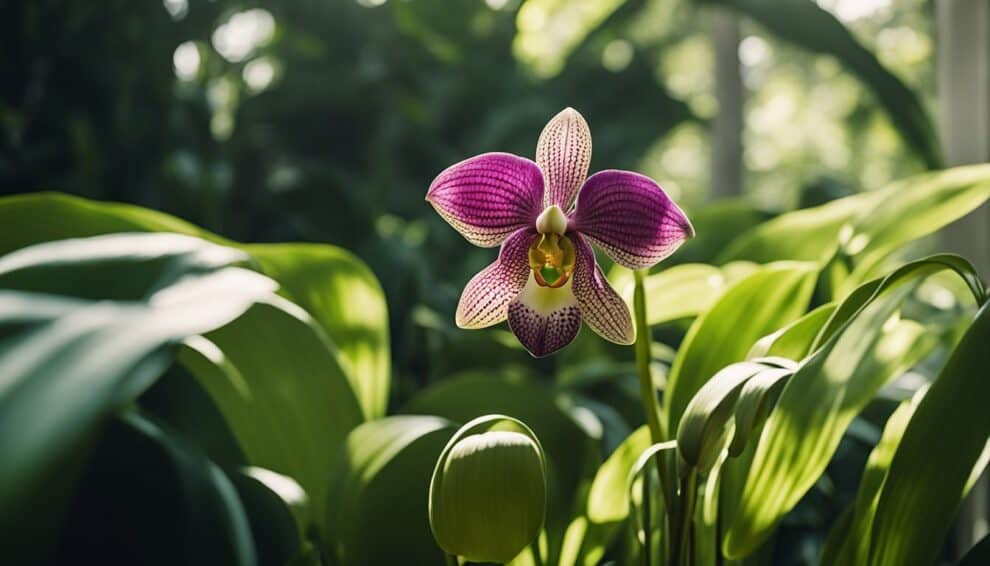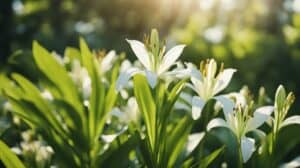Paphiopedilum orchids, commonly known as Slipper Orchids, are a popular choice among orchid enthusiasts.
These unique orchids have a distinctive pouch-like lip that gives them their name.
Paphiopedilum orchids are native to Southeast Asia and are prized for their beautiful blooms and ease of care.

Caring for Paphiopedilum orchids can be simple with the right knowledge and attention.
These orchids prefer bright, indirect light and a well-draining soil mix.
Overwatering can be detrimental to their health, so it’s important to allow the soil to dry out slightly between waterings.
With proper care, Paphiopedilum orchids can bloom for several months and bring joy to any space.
Understanding Paphiopedilum Orchids
Species Overview
Paphiopedilum orchids, commonly known as slipper orchids, are a group of orchids native to Southeast Asia.
These orchids are known for their unique, slipper-shaped pouches that are used to attract pollinators.
There are over 80 recognized species of Paphiopedilum orchids, each with its own unique characteristics.
Paphiopedilum orchids are popular among orchid enthusiasts due to their ease of care and the beautiful, long-lasting blooms they produce.
These orchids can be grown indoors or outdoors, depending on the species and the climate.
Natural Habitat
Paphiopedilum orchids are primarily found in the rainforests of Southeast Asia, including Thailand, Malaysia, Indonesia, and the Philippines.
These orchids typically grow on the forest floor, where they are shaded by the canopy of trees above.
In their natural habitat, Paphiopedilum orchids grow in soil that is rich in organic matter, such as decomposing leaves and bark.
They also require high humidity levels and moderate temperatures to thrive.
Overall, Paphiopedilum orchids are fascinating and beautiful plants that are relatively easy to care for.
By understanding their natural habitat and unique characteristics, orchid enthusiasts can provide the best possible care for these stunning plants.
Essential Care Instructions

Lighting Requirements
Paphiopedilum Orchids require bright but indirect light. Direct sunlight can damage their leaves. A north or east-facing window is ideal for these orchids.
If your orchid is not receiving enough light, its leaves will become dark green.
On the other hand, if it is receiving too much light, its leaves will turn yellow.
Watering Techniques
These orchids require moderate watering. Overwatering can lead to root rot, while underwatering can cause the leaves to wilt.
Water your orchid when the top inch of the potting mix feels dry to the touch.
Be sure to water the orchid thoroughly, allowing the excess water to drain out of the bottom of the pot.
Temperature and Humidity
Paphiopedilum Orchids prefer temperatures between 60 and 75 degrees Fahrenheit during the day and 55 to 65 degrees Fahrenheit at night.
They also require high humidity levels, between 50 and 70 percent.
You can increase the humidity around your orchid by placing a tray of water near it or using a humidifier.
Fertilizing Needs
These orchids require regular fertilization during the growing season. Use a balanced fertilizer with an equal ratio of nitrogen, phosphorus, and potassium.
Fertilize your orchid once a month, following the instructions on the fertilizer package. Avoid fertilizing your orchid during the dormant season.
Potting and Repotting
Paphiopedilum Orchids should be repotted every two to three years. When repotting, use a well-draining potting mix that is specifically designed for orchids.
Be sure to remove any dead or damaged roots before repotting.
After repotting, water your orchid thoroughly and place it in a shaded area for a few days to allow it to adjust to its new pot.
Common Challenges

Pest Management
Paphiopedilum orchids are susceptible to a variety of pests, including spider mites, mealybugs, and scale insects.
To prevent infestations, regularly inspect your orchids for signs of pests and take immediate action if you spot any.
If you do encounter an infestation, there are several methods of pest management you can try.
One option is to use a mild soap solution to wash the affected areas of the plant.
Another option is to use a commercial insecticide specifically formulated for orchids.
Be sure to follow the instructions carefully and avoid using any products that could harm your orchid.
Disease Prevention
Preventing disease is key to keeping your Paphiopedilum orchid healthy.
One of the most important steps you can take is to ensure that your orchid is not overwatered, as excess moisture can lead to root rot and other fungal diseases.
Another important aspect of disease prevention is proper sanitation.
Be sure to remove any dead or decaying plant material from your orchid’s pot and surrounding area.
Additionally, avoid touching your orchid with dirty hands or tools, as this can introduce harmful bacteria or fungi.
By taking these steps to prevent pests and disease, you can help ensure that your Paphiopedilum orchid thrives and blooms beautifully.
Propagation and Blooming

Propagation Methods
Paphiopedilum orchids can be propagated through division or seedlings. Division is the easiest and most common method of propagation.
It involves separating the plant into two or more parts, each with its own root system.
This can be done when the plant has outgrown its container or when it has several new growths.
To divide the plant, gently remove it from its container and carefully separate the roots.
Make sure each division has at least one healthy growth and root system. Repot each division into a container with fresh potting mix and water thoroughly.
Seedlings can also be used to propagate Paphiopedilum orchids, but this method is more complicated and time-consuming.
It involves collecting and sowing the seeds, then waiting for them to germinate and grow into mature plants.
Encouraging Blooms
Paphiopedilum orchids typically bloom once a year, usually in the winter or spring.
To encourage blooms, it is important to provide the plant with the right conditions. This includes proper lighting, temperature, and humidity.
Paphiopedilum orchids prefer bright, indirect light.
Direct sunlight can burn the leaves and flowers, so it is best to place the plant near a window with filtered light.
The ideal temperature range for Paphiopedilum orchids is between 60 and 80 degrees Fahrenheit.
They also prefer high humidity, so it is important to mist the leaves regularly or place a humidifier nearby.
To promote blooming, it is important to provide the plant with a period of cooler temperatures.
This can be achieved by placing the plant in a cooler room or by reducing the temperature at night.
The plant should also be fertilized regularly with a balanced fertilizer to provide it with the nutrients it needs to produce blooms.
Frequently Asked Questions

How should I water my slipper orchid for optimal health?
Paphiopedilum orchids prefer to be kept slightly moist but not overly wet.
It is important to allow the potting mix to dry out slightly between watering, but not to the point of becoming completely dry.
Watering once a week is usually sufficient, but this may vary depending on the specific growing conditions and environment.
Where can I find Paphiopedilum orchids for sale?
Paphiopedilum orchids can be found at many local garden centers, nurseries, and online retailers.
It is important to purchase from a reputable source to ensure that the plant is healthy and disease-free.
What is the best potting mix for Paphiopedilum orchids?
A well-draining potting mix is ideal for Paphiopedilum orchids. A mix of bark, perlite, and charcoal is commonly used.
It is important to avoid using soil or heavy mixes that can retain too much moisture and lead to root rot.
Which fertilizer is recommended for Paphiopedilum orchids, and how often should it be applied?
A balanced fertilizer with equal amounts of nitrogen, phosphorus, and potassium is recommended for Paphiopedilum orchids.
Fertilizer should be applied every two weeks during the growing season, and once a month during the dormant season.
Can you explain the process of propagating Paphiopedilum orchids?
Paphiopedilum orchids can be propagated through division or through seed.
Division involves separating the plant into smaller sections, each with its own growth point and roots.
Seeds can be collected from the plant and grown in a sterile medium.
Propagation can be challenging, and it is recommended to seek advice from a knowledgeable grower.
What are the ideal temperature conditions for growing a healthy Paphiopedilum orchid?
Paphiopedilum orchids prefer temperatures between 60-80°F (15-27°C) during the day and 50-65°F (10-18°C) at night.
It is important to avoid temperature extremes and sudden changes, which can stress the plant and affect its growth and blooming.














